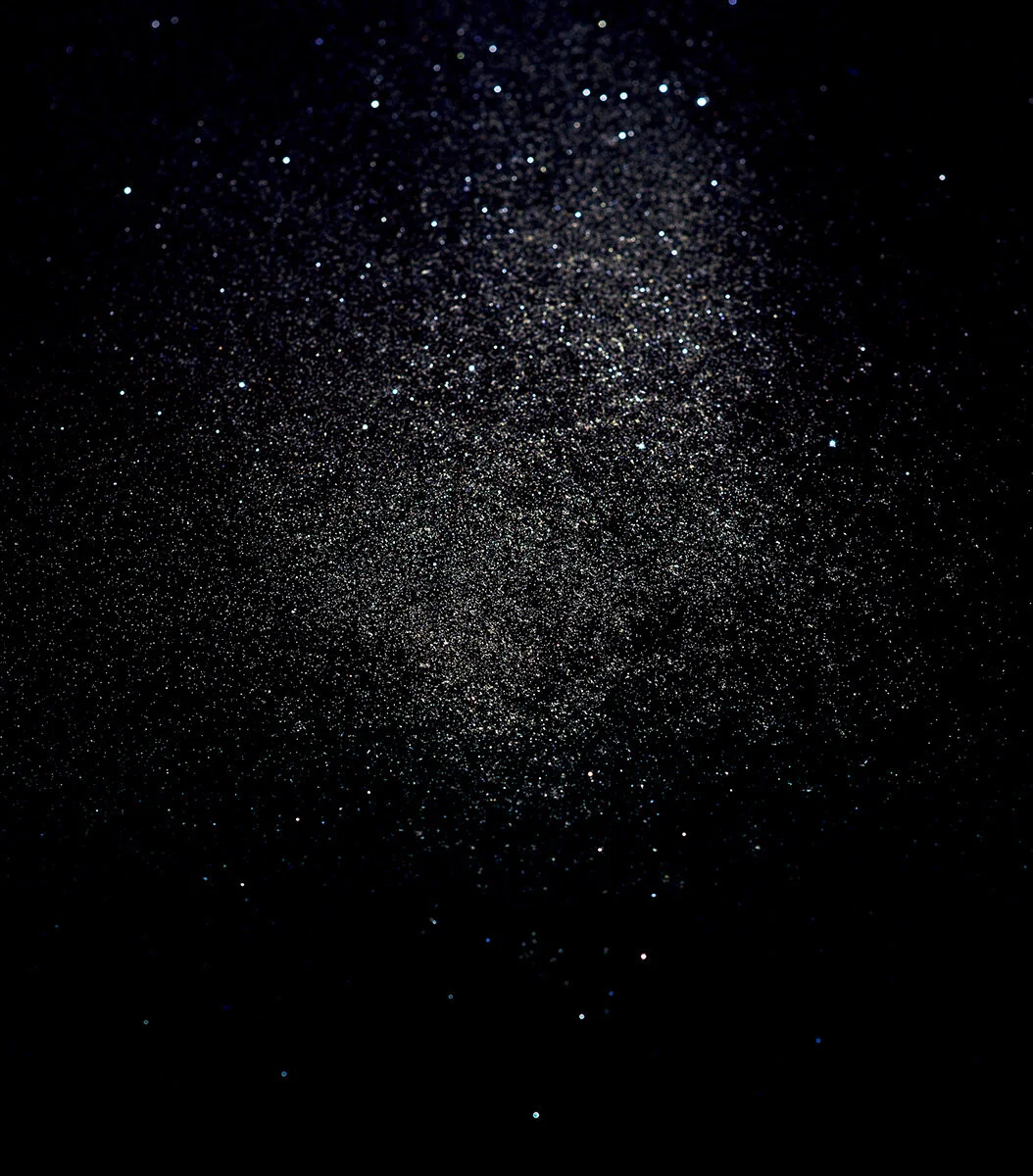Venus. © Lorenzo Triburgo and Sarah Van Dyck
After 10 years of taking testosterone, NYC-based artist Lorenzo Triburgo stopped cold for the duration of their residency and exhibition at Baxter Street Camera Club of NY.
During the process, Triburgo collaborated with partner Sarah Van Dyck to produce a series of glittered environmental performance-portraits that reference art history and contort the ever-complicated gaze. Van Dyck photographed Triburgo in the historically queer haven of Queens, New York City's The People's Beach at Jacob Riis Park, Triburgo's body grounded in a space they describe as “sanctuary and resistance.” Triburgo poses with equal nods to Michaelangelo’s David and Botticelli's Venus, confronting viewers’ potential blindspots to the gray areas of gender identity.
Titling the series Shimmer Shimmer, Triburgo and Van Dyck pace these portraits with photos of glitter representing constellations – a celestial breath of calm, hope, and magic. For Triburgo, this collaboration responds to reductive assumptions of queer and trans identity in popular culture, painting gender as something that is as fluid and enigmatic as the stars above.
Triburgo and I spoke to illuminate, clarify, and perhaps open the door to more questions.
Conjunction © Lorenzo Triburgo and Sarah Van Dyck
Jon Feinstein: Thanks for taking the time to speak with me. To start, I'm drawn to how Sarah frames your body. Each photo is from below. There's a grand, towering feeling that - queue any standard portraiture of visual literacy class - symbolizes empowerment, control, celebration, and maybe even dominance. Why was it important to frame your body this way?
Lorenzo Triburgo: Throughout 2019 we were making compositional studies and exploring ways to visualize our ideas. During this time, we had the opportunity to travel to Paris where we visited the Rodin sculpture garden and museum. We must have been there for at least 6 hours - and it’s not that big, we just couldn’t stop staring at his lines and the way he filled space. We did not take gestures or poses from Rodin -- his figures are too turned-in on themselves and tortured, rather than open and expansive -- but the experience of walking through the garden, rounding a bend and being confronted with an enormous beauty-- that definitely influenced the way we framed our photographs.
Luna © Lorenzo Triburgo and Sarah Van Dyck
Feinstein: Why was it important to you to make this a collaboration with your partner, photographer Sarah Van Dyck vs having it be entirely self-portraits? Did collaborating with Sarah impact, influence, or shed new light on your personal relationship?
Triburgo: I need to go back a little bit to 2018. Sarah and I had just finished making Monumental Resistance: Stonewall when the Trump administration attempted to implement a federally mandated definition of gender as ascribed at birth, according to genital attributes, and forever unalterable. They also erased the word “transgender” from all federal websites. Activists took to the streets and social media creating the campaign #WontBeErased.
Sarah had already wanted to make a photograph that visualized trans*queer masculinity as in conversation with idyllic beauty and I was at a tipping point with feeling frustrated by the invisibility of “passing” and wanted to be as visibly trans*queer as possible. Sarah envisioned me as Botticelli’s “Birth of Venus” and the first version of “Venus” (which we would recreate at Riis the following year) was our response. While in the experimental phase of Shimmer Shimmer we were photographing all the time but kept coming back to that image. We realized that “Venus” -- and the collaborative process of creating it -- was a profound visualization of our ideas.
I also think that collaboration is a form of resistance. Toxic hyper-individualism permeates our U.S. culture (see the refusal to wear face masks during a pandemic!) and is rooted in patriarchal value systems. Collaboration debunks the patriarchal, capitalist myth of the genius as an individual master. I wish Helen Charis Wilson, Edward Weston’s wife, was given credit in her lifetime for her role in “his” portraits of her, and Gerda Taro, Roberta Capa’s girlfriend, was named as the photographer for the images she took that get ascribed to him. Ya know?
In our collaboration we are prioritizing the queer femme perspective, or dare I say “gaze,” and that perspectival agency is the driving force of the project. I never would have made these photographs alone. The act of Sarah looking at me and me performing for her behind the camera is integral to everything Shimmer Shimmer is.
Interstices © Lorenzo Triburgo and Sarah Van Dyck
Feinstein: What prompted you to volley the portraits with celestial/ outer space images?
Triburgo: We think of queerness and trans*queerness as magical ways of being.
(Queer) Astrology is a way for us and our chosen family to engage with a feminist spirituality, without patriarchal religion. The Greco-Roman gods and goddesses informed our visual framing, but in our use of glitter and camp (in addition to my genderqueer body and gestures) we move away from these gendered interpretations and towards a genderqueer, astrological interpretation.
For example, we made “Pluto” in the tunnel leading to the beach because Pluto is recognized as the god of the underworld, but the starry, shimmer of glitter on the figure’s back shifts the title’s meaning from god to planet, and the use of glitter as celestial material (on my body and in the constellation images) reinforces a connection to a queer astrology.
The constellation images are also much smaller in scale at around 7 x 10 inches and 6 x 6 inches. They invite viewers to come closer, there’s an intimacy that the small scale provides that I’m really interested in.
Sol. © Lorenzo Triburgo and Sarah Van Dyck
Feinstein: If you’re open to discussing (I want to be respectful of your personal space on this,) I'm interested in the line and relationship between your decision to de-medicalize as a personal decision and an art performance. Where it gets blurry, overlaps, or stands apart…
Triburgo: I had been taking testosterone (T) for 10 years and passing as “male” for most of that time. I used to say it surprised me when people didn’t know I was trans. I would forget that people didn’t have a way of knowing, really. But more than surprised, over time this got frustrating. It was like, at a certain point, I realized that I was taking T to be the full realization of myself, but that in fact, it was making me invisible.
I started to question whether the sense of self I had was possible to embody while I was always being treated as a cisman. I started taking T because I identify as transgender -- in the sense that my gender is in a state of in-between-ness, of all genders and no genders. But taking T in a world that doesn’t see trans-ness meant that I was being treated and therefore existing in the world as a cisman (aside from spheres where people already knew me).
After 10 years of passing, I also questioned my ability to fully acknowledge my male privilege, but more importantly, I wanted to disavow or shed this privilege, or at least try and see if it was possible. None of this happens in a vacuum of course and it’s important to remember that these feelings intensified when we entered the Trump era.
I felt like I had a political responsibility to be as visible as possible as trans*queer (what I use to identify myself since the word “transgender” has been co-opted by dominant media narratives to mean going from one gender to “the other” gender rather than its original meaning as a state of being that is much more expansive). When I was awarded the CCNY/Baxter St Workspace Residency I decided to stop taking T as a performance that would take place on and off-camera. I think of this decision and ensuing bodily changes as an ongoing performance and my body as the source material for Shimmer Shimmer.
Opposition. © Lorenzo Triburgo and Sarah Van Dyck
Feinstein: From what I understand, so much about this work hovers around the conflicts between queer assimilation and resistance. For example: how you use your body as performance, and the location you chose to photograph yourself in (Riis park, etc.) Can you talk a bit about this?
Triburgo: Riis Beach is an anti-assimilationist space and that is what makes it our queer sanctuary. That section of the beach is backed by an old sanatorium that was condemned as uninhabitable over 20 years ago and is surrounded by chain link and barbed wire. One might think that we are just getting the scraps of what the het people don’t want, but in actuality, we are there among the ruins precisely because the ruins keep others away.
Mars. © Lorenzo Triburgo and Sarah Van Dyck
Feinstein: This might be a stretch, but when I first heard the title, I thought of that Natalie Portman movie Annihilation, where a team of women scientists/soldiers approaches an uncanny jungle environment that has been overtaken by a mystical and unexplainable force called "The Shimmer..."
Rather than rule it out, is there any connection there?
Triburgo: So funny!! I had not even heard of this movie and then 2 weeks ago one of my students reviewed it for their “Bechdel Test” assignment. I watched the trailer and was like, “WHAAAAAT?! The SHIMMER??!!!!” I want to watch it now but I’ve been too scared;) I never watch scary movies because they leave me feeling scared to look behind the shower curtain for like 3 weeks! Should I watch it?!
The title actually comes from Barthes’ notion of the shimmer as described in the Neutral, “...this integrally and almost exhaustively nuanced space is the shimmer [...]: the Neutral is the shimmer: that whose aspect, perhaps whose meaning, is subtly modified according to the angle of the subject’s gaze," and trans media scholar Eliza Steinbock’s excellent use of this to describe visualizing transness in their brilliant book, Shimmering Images: Trans Cinema, Embodiment, and the Aesthetics of Change.
The Neutral; lecture course at the College de France (1977-1978), Roland Barthes
Trine. © Lorenzo Triburgo and Sarah Van Dyck
Feinstein: Ah! That makes so much sense. I wonder if Annihilation was secretly referencing Barthes. I think you should watch it! Shifting gears, what do you hope audiences take with them or glean from this work?
Triburgo: For some, familiarity and solidarity with the figure they see, for others, confusion about their own sexuality and what they had previously thought about gender.
I also wanted to mention that we made video and audio pieces that we thought we would include in the show, but that ultimately I wanted to make a strong installation of photographs. Just photographs. Not mixed media or multimedia. Light rendered on paper is the medium in this project and that’s as important conceptually as it is aesthetically for me.
Neptune. © Lorenzo Triburgo and Sarah Van Dyck
Feinstein: Building on that, what has the response been to this work so far, and to your exhibition at CCNY?
Triburgo: Showing Shimmer Shimmer at Baxter over the last month was honestly incredible. An opening wasn’t possible so I made it a point to be at the gallery all month and got to really spend time connecting with visitors, a lot of times one-on-one. Sarah and I had inspiring and real conversations about the importance of place and space for artists and queer communities — in particular as artists and other under-recognized cultural producers are having to leave the city due to loss of income and no rent relief.
That was something we could not have imagined when we made the first images in January 2020. The image "Luna" was created during the full moon in March, just a few days before quarantine started and we had no idea what was coming. Having these conversations in front of photographs of a trans/genderqueer figure shimmering with glitter and taking up metaphorical and literal space in an important public space for queers in NYC (Riis Beach) contributed to the sense of hope that we set out to create.
It was also the first show a lot of people had seen since quarantine which was emotional for everyone. More than a few people responded with, “Thank you for the reminder on why I continue to live in this city.” Of all the praise, those comments were the ones that hit us in the gut, in the heart.
Please remember that for folx like me and Sarah who haven’t left Brooklyn/NYC at all in 2020 it can be easy to question why one would choose to continue to live here. It’s hard here in the best of times but with no rent relief for an overpriced apartment, no place to literally be outdoors when they shut down all the parks (in working class and predominantly POC neighborhoods), the sanitation department cutting back services leaving the streets to the rats (in working class and predominantly POC neighborhoods), and the injustices of the healthcare system and wealth disparities that exist throughout the U.S. playing out in front of your eyes and backed by a racist and terrifyingly powerful police department, getting to convene around art and connect felt life-giving.
That’s why those comments meant so much.
Sextile. © Lorenzo Triburgo and Sarah Van Dyck
Feinstein: Beyond yourself, who are you making this work for?
Triburgo: It’s for activists, scholars, artists, historians, the people of NYC, my creative community, my queer community, anyone who needs a reminder to stand tall and fabulous. Anyone making sacrifices to do good work in the world. The queers who first claimed space at Riis in the 1940’s, the queers who continue to stake a claim, and for the next generation who will swim freely.











